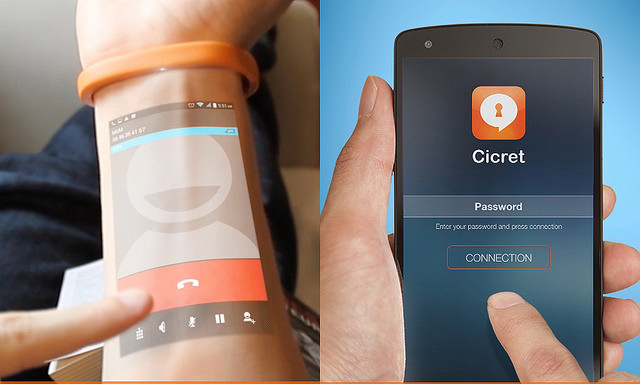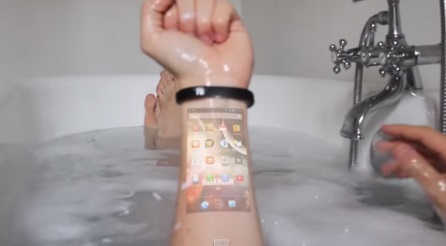What’s The Big ‘Cicret’ About The New Tablet For Your Skin?

A new product has everyone talking, but many are incredibly skeptical, some going as far as calling the new Cicret bracelet a scam, but is it?
The new Cicret bracelet, made by the company Cicret in Paris, France, is best described by their online video, as “like a tablet, but on your skin”. The users in the video are wearing the bracelet, which is a thin plastic wristband and they simply flick their wrist to turn on the Android touch-screen surface. The band is equipped with a picoprojector and an array of proximity sensors that emits images onto your forearm. As you interact with the image, the proximity sensors determine the gesture action and execute on demand. A set of eight proximity sensors along the wristband create the touch interface. It is loaded with unseen electronic components that give it all the functionality of a smartwatch and more.
[one_fourth]
[/one_fourth][three_fourth_last]
So why all the controversy? Appears that when the video and crowdfunding for financing was developed, including a Facebook page and website to promote the product, some felt it wasn’t clear was that this was still just an idea and that a prototype had not yet been built. Many felt that since the technology seemed incomprehensible, then it must have been a scam. Even those with scientific backgrounds chimed in and said it was impossible.
Since all the ‘haters’ started their skepticism back in December, the company has since built their first prototype. So much for the impossible, right?
I contacted the company and received an email statement about the criticism from one of the four founders, Guillaume Pommier. “We get the confirmation that the demand is huge, we created a working prototype and we have a precise, global and world wide sales strategy,” he said. “We are going on so, basically, whatever people think, we will continue to work hard all day and are still going to make it. If those guys don’t trust us, whatever: they simply won’t see us coming.”
According to Pommier, they are getting proof that all their technology choices are working well together. The company’s next concern is to create a pre-produced version of the bracelet. “We are already in discussion with a design office here in France and the target is to produce it for the end of 2015/beginning of 2016 with a cost between 200 and 400 euros, or around $300-500.00 US,” he said.
If this product seems too good to be true, we suggest keeping an eye on it through their social media or web page. If it happens, it does. If it doesn’t who’s to say it never will?






